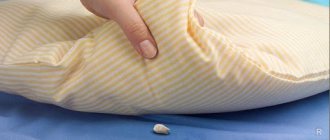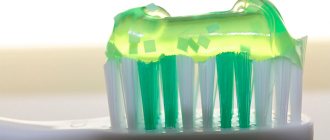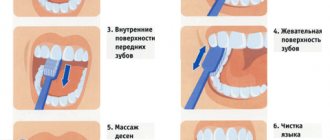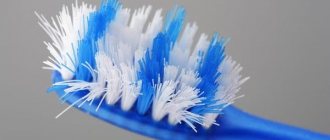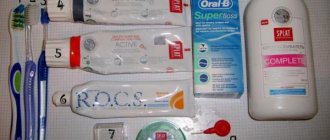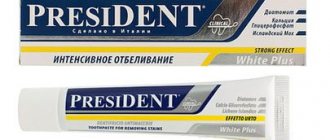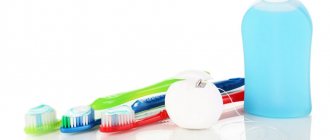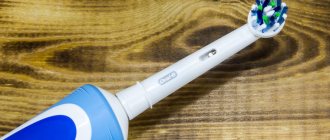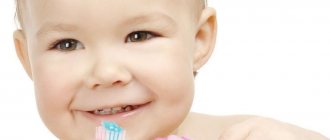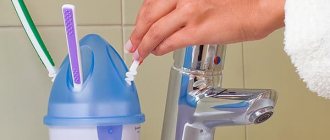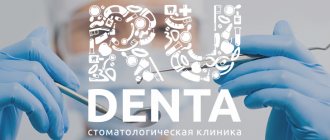How to disinfect a toothbrush
How to disinfect a toothbrush at home
There are many more or less effective ways, let's talk about the most common ones.
- Boiling. You need to boil for fifteen minutes, then dry thoroughly. This method has a significant drawback: it damages the bristles, and they quickly wear out. In addition, this method is not suitable for electric brushes.
- Disinfection in rinse aid. Any mouthwash contains antibacterial components, so this method is completely justified.
- Chlorhexidine. The brush remains overnight in a solution of chlorhexidine (0.2%), which prevents the development and reproduction of microorganisms.
- Special tablets. They contain citric acid, sodium bicarbonate, sodium lauryl sulfate. The tablets are quite easy to use and have an affordable price.
- Vinegar. Fill a clean glass with vinegar and lower the toothbrush head down into it. Leave for several hours. After this, rinse it with clean running water. This method is not the best, since in such an aggressive environment the bristles can deteriorate and wear out faster. Plus, the smell and taste of vinegar is not that easy to get rid of.
Sterilizer for toothbrushes
Ultraviolet sterilizers are the most effective. As a rule, the lid of such devices is transparent, so radiation breaks through it, which can be used to understand whether the device is working or not. The sterilization process takes only ten minutes, after which the device will automatically turn off.
Ultraviolet light has been proven to fight bacteria and microorganisms much more effectively than devices that disinfect using steam or sound waves.
Toothbrush sterilizers from the Russian brand Timson performed very well. To disinfect, it is enough to place the brush in the device for only 6-7 minutes. This device is easy to use and can be taken with you on trips, as it has the shape of a case. The case is adapted to fit any size brushes, including electric brush heads. The sterilizer runs on two AAA batteries.
Tips for caring for and storing toothbrushes
By following these simple rules, you will keep your teeth healthy for a long time, you will recover faster from a cold, and you will forget about bad breath.
- Each person in the family should have their own toothbrush. Under no circumstances should it be used by unauthorized persons.
- Buy new brushes regularly (every two to three months). They should also be replaced after dental treatment at the dentist. It’s easy to understand that you need to throw away the brush: this should be done if the bristles are bent. Also today there are brushes with color indicators of wear.
- If the brush is not changed regularly, micro cracks will form on the bristles over time, which will also harbor bacteria.
- It is not advisable to store all the brushes in one cup, because bacteria spread easily. In addition, the cups need to be washed regularly. Place the brushes in a glass with the head up - this way the bristles will retain their shape longer, and the number of pathogens on the bristles will decrease. The storage cup should not be too high and not too low. The head of the brush should be well above the rim, but not so much that the brush falls out of the cup.
- After brushing your teeth, do not be lazy to rinse the villi thoroughly to remove toothpaste and food particles.
- It is forbidden to store the brush in the open air, because dirt and dust will settle on it. This rule is mostly for vacationers.
- At the same time, you should also not leave wet brushes in closed cases, because moisture is an excellent habitat for pathogens. Cases can be used exclusively for transportation when you are traveling somewhere.
- Rules for washing the brush after use: rinse it thoroughly under a hot stream, then shake it off, and place it head up in a clean glass. This way, excess moisture will quickly drain and evaporate under the influence of gravity.
- A new brush does not need to be disinfected before use. This stereotype has been entrenched since Soviet times, when brushes were made from natural materials and sold open, without packaging. Modern brushes are made from synthetic materials; if you boil them, this will damage the bristles and cause microcracks where microorganisms will accumulate. After removing a modern toothbrush from its packaging, it is enough to simply wash it with warm water and soap.
- Cups for storing brushes come in many different forms, but no matter what you choose - a special rack or a regular cup - you need to put a disposable paper towel under it. This way you will get rid of liquids with bacteria, and they will not come into contact with other surfaces in the bathroom.
- Containers with brushes should be located away from other surfaces in the bathroom so that the bristles do not come into contact with various sources of pollution (wall, cabinet, toilet, etc.) The distance between the container with brushes and the toilet should be at least one to two meters, so that when draining particles Water never came into contact with the brush.
- A very convenient way to store brushes is a special holder that is attached to the wall above the sink.
How to properly store a toothbrush
Proper Ways to Store Toothbrushes
Before we move on to the question of how to disinfect a toothbrush at home, let’s look at the instructions for preserving this hygiene item. This is no less important, since if these rules are violated, all efforts after disinfection will be neutralized.
Please note the following points:
- A toothbrush is a personal hygiene item, so each family member should have their own.
- You should not allow a situation where all the brushes are in one glass (which happens quite often), since pathogenic microflora can quite easily spread to nearby devices, especially when they are wet. It is important to ensure that toothbrushes are stored in the bathroom in such a way that each person has a separate glass.
- Upon completion of brushing your teeth, which is preferably done not before, but after breakfast, make sure that all food residues are removed from the bristles under a stream of water; if this is not done, the remaining organic matter will serve as an excellent breeding ground for putrefactive and pathogenic microorganisms.
- Provide fresh air access to the bristles - the head should be located outside the edge of the glass; you should not place it in various cases or put on caps, unless these are special devices for disinfection. Bacteria cannot live and reproduce in a dry environment. In addition, dried bristles will last longer.
- Make sure the storage cup is clean.
Never store toothbrushes near the toilet. Remember the vintage ceramic mounts that were popular in homes built in the 1950s and 1960s? They matched the appearance of the tiles and were almost always placed on the wall to the left or right of the toilet. It doesn't look terrible so much as it is unhygienic. After some time, people realized that all germs from the toilet move into the oral cavity at least twice a day.
Also, don't put your toothbrush in your medicine cabinet. If you're so used to keeping it there that you can't wean yourself off, place a toothbrush holder inside. This is the safest way to block the path of germs from the toilet.
Toothbrush storage
How to properly care for your toothbrush?
Dentists all over the world insist that you not only need to perform regular oral hygiene, but also clean your toothbrush properly. Along with the plaque, many microbes settle on it. The most dangerous of them are staphylococcus and E. coli. If a tool is infected, it becomes unsafe to use. This can lead to the development of diseases. Proper brush care, disinfection and timely replacement will help you avoid many problems.
Conclusion
If you don’t want to regularly spend money on new toothbrushes, then just use the life hack that my dentist taught me. Making a soda solution is incredibly simple and will cost mere pennies - place a glass of it on your sink and use it regularly for cleaning. You will notice how much cleaner and fresher your brush will look even after using it for several months.
Found a violation? Report content
How to properly wash a brush?
Perhaps it's worth starting with the first use of a new brush. You can often hear advice to pour boiling water over the head with bristles before the first use. However, when freshly unpacked, the brush is sterile and free of any bacteria. Rather, this method helps soften the synthetic hairs a little so that they do not scratch the gums.
But with each further use, you should follow a number of simple rules:
- Before picking up a brush, remember to wash your hands with soap.
- Before brushing your teeth, rinse your toothbrush with warm water.
- After cleaning, the bristles are washed more thoroughly. You need to rub it with your finger under running warm water to free it from toothpaste and plaque.
- If desired, the brush can be washed with soap if it still seems dirty. But in general there is no such need.
- After rinsing, shake off any remaining water and let the brush dry in an upright position.
Dirty toothbrush
However, like most people, after brushing my teeth, I simply rinse the brush under water. However, this does not mean that it becomes clean - a lot of dirt and bacteria collect between the bristles. This is why dentists say that you should change your toothbrushes regularly to avoid putting something in your mouth that is home to millions of harmful microorganisms.
However, if you regularly clean your brush correctly, it can serve you much longer. Below are the tips my dentist gave me. They help keep my toothbrush clean.
What awaits us: doctors spoke about alarming symptoms during vaccination against COVID-19
The opening ceremony will make even the home Olympics official
A friend said that a person's lack of money leads to weight gain
Disinfection
Every 2 weeks, the toothbrush must be disinfected in an antibacterial solution. This will reduce the number of germs. You should also definitely resort to the procedure after suffering from a cold or professional teeth cleaning. Although the opinions of dentists in this case differ. Some believe that disinfection is enough, others advise purchasing a new hygiene item and throwing away the old one.
How can you disinfect a toothbrush?
In addition to antibacterial solutions, special devices are used to treat brushes. They are called ultraviolet sterilizers or toothbrush disinfectors and cost about 1000–1500 rubles. The work is based on disinfection with ultraviolet rays. The device operates from a 220 volt stationary network. It is equipped with a fastening system for wall mounting, as well as various clamps. Having a disinfectant makes caring for your toothbrushes much easier. It is also suitable for disinfecting razors.
Disinfection of toothbrushes
Over time, microorganisms still accumulate in the bristles. To prevent them from migrating back into your mouth, they need to be disinfected periodically . Use any of the methods below and sleep peacefully.
There are special sterilizers for brushes that can be stored on the wall. They have built-in ultraviolet and ozone lamps, from which all microorganisms are horrified and die immediately. If you have any simple ultraviolet lamp , that will do too.
Some people boil their brushes the old-fashioned way, believing that this helps fight germs. Perhaps you will destroy most of them, but along with them, the brush itself gradually dies. The plastic from which it is made is not intended for such high temperatures, which means it deteriorates, which means it can no longer perform its functions as well as before. So forget about boiling water and use special ways to keep your brushes clean and safe.
A couple of times a week, soak the bristles in a mouthwash with antibacterial additives for half an hour (you can leave it overnight). Alcohol is also good. Don't forget to rinse and dry your brush thoroughly after this procedure.
After each use, it is advisable to rinse your brush well in warm running water. It will remove food particles that are stuck among the lint. Then the pile is wiped with a dry cloth and sent to a permanent storage place.
Storage rules
Germs simply love dark, damp, cool places, like the bathroom. In such conditions, they remain viable for a long time and reproduce. For example, on a poorly washed wet brush. The correct way to store it is as follows:
- Use a special vertical cup with a separate hole for each toothbrush. It is important to avoid cross-contamination from other surfaces, including brushes from other family members.
- Take care of ventilation. The washed bristles should dry completely. Do not place the brush directly into the container. By and large, it is intended only for transportation or storage on the road.
- For a shared bathroom, choose a storage location away from the toilet. When flushed, harmful particles enter the air and then settle on nearby surfaces within a radius of 1.8 m. If it is impossible to move the brush over such a distance, you should purchase a protective cap with ventilation holes.
- Keep the brush storage container clean. Wash the cup or holder at least once a week with soap and hot water. To remove stains, use baking soda and a sponge that has not been used on the sink or other surfaces.
Basic rules for storing toothbrushes
The first thing we do when we want to do something beautiful is go to the Internet. And there is a sea of bright designer pictures and photographs. And let’s implement them, without thinking that it’s not just about interior details.
For example, as paradoxical as it may sound, the bathroom is not the best place to store toothbrushes . Warm, humid, and mostly dark environments are ideal conditions for bacteria to grow. And there are enough of them on the bristles of a dental assistant. It's best to keep brushes in a dry place , like a linen closet in your bedroom.
Keep brushes away from the toilet
The worst and most dangerous thing you can do is store toothbrushes next to an open toilet if you have a shared bathroom. Most of humanity does not even suspect that when flushed, “toilet” bacteria can soar into the air at a distance of up to 2 meters! And, accordingly, settle on open razor blades, towels and, of course, toothbrush bristles. Therefore, follow an important rule: always close the toilet lid before flushing . You can, of course, put the brushes in the cabinet, but it’s still dark and damp there... But compared to the prospect of brushing your teeth with E. coli, it doesn’t look so scary.
All brushes must be stored separately
Each family member’s toothbrush should be separate from its “colleagues.” Do not allow the bristles of different brushes to come into contact with each other. Microbes are fast - new territories are what they need and, without wasting time, they immediately spread to all the brushes, which is absolutely unacceptable. Buy a glass with multiple holes or give each person their own glass .
This can be especially dangerous if there are both children's and adult brushes in the same place.
Important!
Children's brushes should never be shared with adults.
Set aside a separate place for children's brushes. Please note that the brushes are covered with a cap to protect them from dust, dirt, moisture, etc.
You shouldn’t leave your toothbrush on the sink after brushing your teeth because of the same unfriendly living creatures and high humidity.
Dry toothbrushes - and bacteria will have a hard time . Do this:
- shake the brush vigorously to get rid of water.
- Dry the brush with a towel (or paper) or a hairdryer.
- Never keep brushes in closed travel cases. If you put it away, then only put it completely dry in cases or caps with ventilation (holes).
- If you place the brush in a glass, only with the bristles up and the handle down. The remaining water will drain away, and the bristles will be exposed to air and dry faster.
Brushes should not be placed near the shower
Drops of water falling on the bristles will not allow them to dry out and they will remain wet all the time, and this, again, is an environment for microorganisms.
Brush cups must be clean
themselves need to be kept clean so as not to breed rot or mold there and not get this result:
It is very important to replace toothbrushes promptly
No matter how carefully you take care of your hygiene assistant, dentists recommend changing your brush at least once every 3 months. Throw it away without regret and replace it with a new one. In order not to forget the last time you did this, change the brush at the beginning of each season of the year , it will be easier to remember: summer begins - buy a new brush, the autumn rains have begun - it’s time to go to the store for a new brush, the first snowball - where’s my new one? Toothbrush? Treat an old item wisely and trust it to clean, for example, rust stains from clothing or furniture.
By the way, here is another video on how to use a used toothbrush in everyday life .
An unscheduled brush replacement is required if you have had a viral disease . You're getting better, but the viruses on your brush are just waiting to crawl back into your mouth and throw a new party in your body.
Proper use is important
Following good personal hygiene will not only keep your teeth healthy, but will also minimize the risk of bacteria colonizing your toothbrush. For it to serve faithfully, it is necessary:
- Use only a separate, personal brush. The oral cavity of every person is teeming with billions of bacteria. At the same time, everyone has their own microflora, which is in harmonious coexistence with the body. When someone else's microflora gets into another person's mouth, the result can be unpredictable. To protect themselves from diseases, all family members, including husband and wife, should have personal brushes.
- Brush your teeth regularly in the morning and evening for 5-6 minutes. Timely cleaning helps suppress the proliferation of microbes in the oral cavity. Accordingly, there are fewer of them left on the brush.
- Choose the right bristle stiffness and toothpaste. The less bacteria in your mouth, the cleaner your stubble remains. The correct selection of toothpaste and brush guarantees complete cleansing of teeth from plaque, in which pathogenic microorganisms live.
- After each meal, use dental floss and mouthwash. Brushing your teeth 3-4 times a day is practically impossible physically, and is also traumatic for tooth enamel. However, to prevent food debris from rotting between the teeth, they must be removed and washed off with mouthwash.
- Change your toothbrush every 3 months. Numerous studies have confirmed that within 90 days the brush is colonized by pathogenic organisms from the oral cavity. Even high-quality disinfection does not destroy them. In addition, during this period, with regular use, the bristles wear out, and they can no longer properly clean the teeth.
- Buy a new brush after an infectious disease or professional teeth cleaning. Antibodies fight infection in the body. But pathogens survive well on a toothbrush, so it is recommended to change it after an illness. As for professional sanitation, it destroys 99.9% of harmful microorganisms in the mouth. To ensure that the cleaning result lasts as long as possible, it is better to throw away the old hygiene item with bacteria or give it a second life as a device for cleaning hard-to-reach surfaces.
Electric brush care
In general, you need to care for an electric toothbrush in the same way as a regular one. The processing rules are not too different. The pocket with batteries and microcircuit is reliably protected from moisture, so the device can be washed without fear.
However, there are several important nuances that need to be taken into account when caring for an electric brush:
- The bristle head wears out within 3 months and must be replaced.
- Discharged batteries should never be left in the device. They may start to leak. Then not only will the brush be damaged, but the acid may get into your mouth and cause poisoning.
- After use, the electric brush should be rinsed with warm water and dried.
When trying to disinfect the device, it is important not to overdo it. Boiling may cause the product to melt. According to GOST, an indicator of 1000 CFU/cm 3 of microorganisms on bristles is the norm and, in the absence of diseases of the immune system, cannot lead to infection.
Every day, billions of bacteria come into contact with your toothbrush from your mouth. Among them are streptococci, staphylococci, E. coli, porphyromonas gingivalis, herpes and hepatitis viruses A, B, C, candida albicans, coliform and many others. Improper care can lead to frequent illnesses. It is important to thoroughly wash and dry the bristles, choose a suitable place to store brushes, and observe personal hygiene rules. Every 3 months the device must be replaced.
What should be the cleaning technique?
There are many different techniques. It is difficult to say which of them is more effective, because very little research has been conducted on this topic. Basically, dental associations (for example, American, Canadian) recommend to patients the modified Bass technique, which allows you to remove plaque not only from the supragingival part of the teeth, but also partially from under the gingival pockets.
Step-by-step cleaning according to Bass looks like this:
- Wet your toothbrush and squeeze a pea-sized amount of toothpaste into the middle of the head.
- Place the brush at the far chewing teeth, at an angle of 45°. Use gentle circular movements to clean your teeth from the gums to the incisal edge.
- Gradually move the brush along the jaw - to the front teeth and the next chewing ones.
- Once you're done with the outside, brush the inside of your teeth. In this case, the brush must be placed perpendicular to the gum. The movements are the same: from the gums to the cutting edge of the teeth.
- Repeat the same with the other jaw.
- Brush the chewing surfaces of your teeth 2-3 times.
- When finished, brush your tongue.
Which brushes are better: manual or electric?
Research has shown that electric toothbrushes are better at removing plaque from teeth. But the advantage is actually negligible. If when using a manual (manual) brush, the plaque index on average decreases to 42% of the initial level, then when cleaning with electric brushes - to 46%. Most experts believe that such a difference does not significantly affect dental health in the future. Therefore, you can choose the brush that you find most pleasant and convenient for yourself.
Electric brushes may be better suited for people with arthritis and other conditions that make it difficult to use a regular brush. They are also easier to clean teeth if you have braces.
An important rule: if you choose an electric brush with a rotating head, do not brush your teeth with it in a circular motion (as is recommended to do with manual brushes). Just press the head of the brush against the surface of the tooth - it should do all the cleaning movements itself.
Toothbrush: how to choose
Proper and regular oral hygiene is the key to the health and beauty of your smile. The effectiveness of brushing your teeth depends not only and not so much on the choice of toothpaste, but on the quality of the brush. It is the effectiveness of mechanical treatment of teeth, gums and the surface of the tongue that ensures the elimination of food debris, plaque and bacteria that cause dental diseases. That is why you need to approach the choice of a toothbrush carefully and seriously.
Simple toothbrush
The main criterion for choosing a regular toothbrush is the degree of stiffness of its bristles: soft, medium and hard.
The soft brush is suitable for preschool children and adults with sensitive gums (as recommended by a doctor).
The medium hardness of the brush is universal - such hygiene products are used most often by children and adults.
to buy a hard brush without consulting a dentist - the effectiveness of active mechanical cleaning is not always justified due to the high risk of damage to the enamel.
Whether to choose a brush made of artificial or natural bristles, whether rubber inserts are needed and whether the difference in the length of the bristles is fundamental - there is no universal answer to these questions, since different doctors give different recommendations.
The cost of ordinary toothbrushes varies from 20 to 500 rubles.
Ionic toothbrush
What makes an ionic toothbrush different from a regular toothbrush is the titanium coating of the rod, which helps release electrons. Mixing with saliva, negatively charged particles attract hydrogen ions with a positive charge - this interaction ensures effective neutralization of acid and microbes.
When using an ionic toothbrush, a molecular effect occurs on bacteria, and saliva is saturated with electrons for a prolonged healing effect. Manufacturers of ionic toothbrushes talk about the effectiveness of their products even without the use of toothpaste.
The cost of a brush is from 500 to 1000 rubles.
An electric toothbrush
Electric toothbrushes are very popular today, and the demand for them is not just a tribute to fashion. The use of toothbrushes with different impulses of movement demonstrates effectiveness in the prevention of dental diseases - pulsing the head helps soften plaque, and reciprocating movements remove it from the surface of each tooth without damaging the enamel. Some manufacturers produce electric brushes with different cleaning modes (for teeth, gums and tongue) and different attachments.
Such devices, depending on the specific brand and model, can cost from 1,000 to 5,000 rubles.
Ultrasonic toothbrush
The latest development in household dentistry is an ultrasonic toothbrush, which provides an effective preventive effect on teeth and gums with ultrasound at a frequency of 1.6 MHz. This effect not only helps clean the surface of the teeth and gums, but also disinfects the tissues of the oral cavity up to 5 mm inside.
A person does not feel the impact of such a low frequency of waves, and microbes are guaranteed to die, and the oral cavity is cleansed, keeping it clean and fresh for a long time. Users and dentists positively assessed the new product - despite the high cost, ultrasonic toothbrushes have become widespread in many countries around the world, including Russia.
The price of a high-tech invention varies from 4,000 to 7,000 rubles.
What about pastas? Which ones are better?
For daily use, fluoride toothpastes are recommended for both adults and children.
Fluoride has been proven to strengthen enamel and reduce the risk of caries. Adults should choose pastes with a fluoride content of 1350-1500 ppm. This indicator is indicated in the composition of the paste on the tube or cardboard packaging.
Children can use regular “adult” paste, but a very small pea is enough for them. If a child under 6 years of age does not have caries, he can buy toothpaste with a reduced fluoride concentration - 1000 ppm.
After using the paste, do not rinse your mouth vigorously - otherwise you will wash away all the fluorides and they will not have time to act. You can even just spit out the paste.
To remove plaque more effectively, you are allowed to periodically brush your teeth with whitening pastes - but in short courses and only if there are no problems with your gums.
Special “medicinal” pastes (for example, desensitizing for sensitive teeth or with triclosan for sore gums) are best used after consultation with a specialist. Most likely, paste alone will not solve the problem, but the doctor will help you choose the right treatment.
Threads, brushes, irrigators - is all this really necessary?
Threads and brushes are necessary for cleaning interdental spaces. They remove plaque that a brush cannot reach. Using these tools, you can significantly reduce the risk of developing contact caries - its most common type, which affects the joints of adjacent teeth.
The appropriate thread thickness and brush size must be selected individually by the hygienist. For this, a special probe is used, which is inserted into the interdental space.
The irrigator complements teeth brushing and flossing. It helps remove soft plaque from gum pockets and interdental spaces, and in addition, massages the gums. It is believed that this device is primarily necessary for people with sore gums and artificial structures in the mouth: braces, implants and conventional dentures.
What about foams and rinses?
By and large, you can do without them. If you clean your teeth well and use fluoride toothpaste, foams and rinses will not significantly affect the risk of caries.
For patients with gingivitis, periodontitis or halitosis (bad breath), special antiseptic rinses may be recommended, but they should not be overused.
Some antiseptics (for example, chlorhexidine and cetylpyridinium chloride) can cause permanent staining of teeth and changes in taste.
Did you like the material? Like and subscribe. We write about how to keep your teeth healthy and what to do if problems arise.

